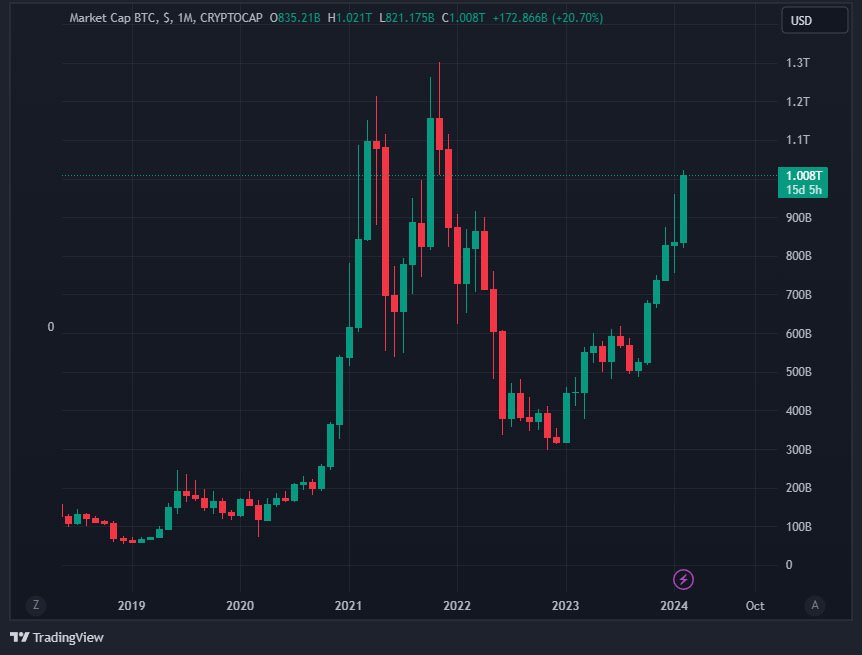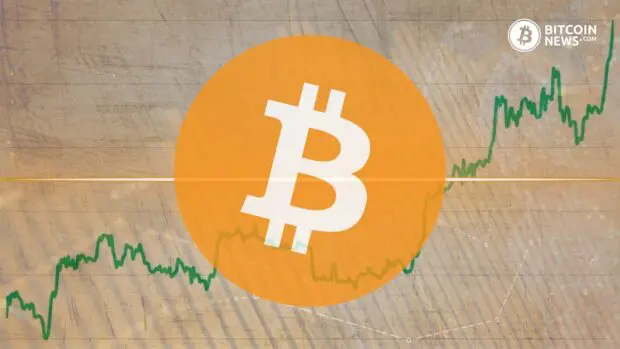Bitcoin, the pioneering digital asset, has once again soared past the $1 trillion market cap mark, igniting optimism and excitement in the digital currency realm. Recent developments and price surge lead to this monumental achievement, as bitcoin market cap regains its 2022 levels.

Bitcoin Market Cap: $1 Trillion Reclaimed
In a remarkable resurgence, Bitcoin has reclaimed its $1 trillion market cap for the first time since November 2021. This milestone comes on the heels of a substantial 19.5% surge in the last seven days, with bitcoin trading at over $51,200, according to CoinMarketCap data. The digital asset community is abuzz with speculation that the upcoming Bitcoin halving in April may propel the digital money towards retesting its all-time high level of $69,000.
The CEO of BuyUcoin Shivam Thakral stated on the matter:
“The macro factors such as the anticipated rate cut by the US Fed and the growing popularity of Bitcoin ETFs will drive the market in the mid to long term. We can expect Bitcoin to retest its all-time high of $69,000 post-halving,”
Bitcoin ETFs Driving the Rally
Several factors have fueled Bitcoin’s remarkable rally. One significant catalyst is the approval and subsequent listing of Bitcoin Spot Exchange-Traded Funds (ETFs) in the United States, with nine ETFs making their debut alongside the conversion of the Grayscale Bitcoin Trust into an ETF. The accessibility of ETFs has attracted approximately over $10 billion in funds, promising to expand the investor base for Bitcoin.
James Butterfill, who serves as the research lead at CoinShares, a company specializing in managing assets focused on digital assets, said:
“Yesterday, we saw $651 million [in] inflows, the largest daily inflow since the launch day […] Furthermore, there was 12,000 bitcoin demanded by the issuers yesterday at a time when only 900 is produced every day. Investors are beginning to realize that demand is beginning to outstrip newly issued supply.”
Ryan Lee, who holds the position of chief analyst at Bitget Research, said:
“From January 1 to January 10, Bitcoin trading volumes grew from $16 billion to $50 billion – a 300 per cent increase. This is the impact of the approved Bitcoin ETF.”
Anticipation of Bitcoin Halving
Another key driver of the surge is the anticipation surrounding the upcoming Bitcoin halving scheduled for April. This event, which occurs roughly every four years, reduces the quantity of bitcoin that miners receive for verifying transactions on the blockchain. This halving, slated for April 2024, cuts the miners’ rewards from 6.25 BTC to 3.125 BTC. Historical data suggests that Bitcoin halving events often provide support for prices, leading to significant price rallies in the months following the halving.
Caroline Mauron, who is one of the founders of Orbit Markets, a company specializing in digital asset derivatives liquidity, said:
“We expect the market to take a short pause here after a spectacular four-month-long rally, before the upcoming Bitcoin halving takes over the narrative.”
Impressive Resilience Amid Challenges
Despite facing challenges such as regulatory scrutiny and market volatility, Bitcoin has displayed impressive resilience. The recent surge in demand for bitcoin has been attributed to the success of newly launched U.S. spot Bitcoin ETFs, which have witnessed significant inflows since their inception. This sector-specific factor, which is the debut of Bitcoin-focused ETFs from prominent financial institutions like BlackRock Inc. and Fidelity Investments and their significant success so far, have bolstered investor confidence in bitcoin’s long-term potential.
Despite worsening risk sentiment overnight, Bitcoin demonstrated remarkable resilience, according to market analyst Tony Sycamore, a market analyst affiliated with IG Australia Pty. Technical analysis suggests a potential temporary decline to the high $30,000s.
He stated:
“Bitcoin showed impressive resilience despite the overnight deterioration in risk sentiment.”
Market Sentiment and Technical Analysis
While the recent rally has sparked optimism among investors, some analysts caution that technical signals suggest a temporary dip in Bitcoin’s price.
Technical analysis based on chart patterns indicates the possibility of a temporary correction, potentially leading to a short-term decline in bitcoin’s value. However, many remain optimistic about bitcoin’s long-term prospects, citing the forthcoming halving event and increasing institutional adoption as reasons for continued bullishness.
In an analysis, Grayscale reported that they believe this halving event would be “actually different” from previous ones, stating:
“Post-halving, these requirements will decrease by half: with only 3.125 Bitcoin mined per block, that equates to a decrease to $7 billion annually, effectively easing the sell pressure.”
The report states that the upcoming Bitcoin halving is expected to have a significant impact on the digita asset’s supply dynamics. With the mining reward set to decrease by half, Bitcoin’s annual inflation rate will also decrease, potentially easing sell pressure on the market. This reduction in sell pressure could contribute to further price appreciation, as demand for bitcoin continues to outstrip newly mined supply.
Conclusion
Bitcoin’s resurgence past the $1 trillion market cap milestone signifies a significant milestone for the digital asset market. With factors such as ETF adoption, anticipation of the upcoming halving, and increasing institutional interest driving Bitcoin’s rally, the digital currency landscape is poised for further growth and innovation. Despite short-term fluctuations, the long-term outlook for bitcoin remains optimistic, with many investors betting on its potential to redefine the future of finance.










